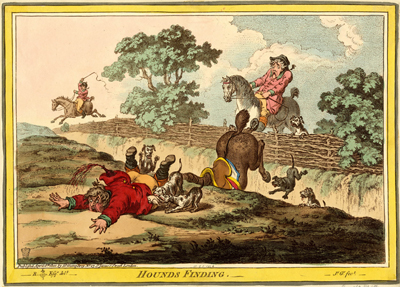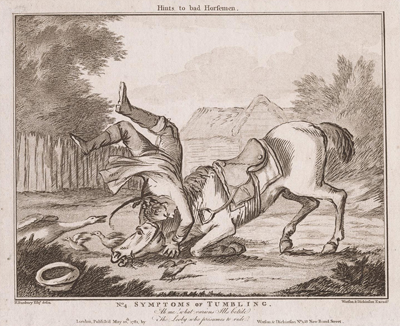Hounds Finding
In the last half of the 18th century, hunting scenes (especially fox-hunting scenes) were increasingly popular in England. This is hardly surprising, for they combined into one nostalgic image the picturesque English countryside, an Englishman's two favorite animals (his horses and his dogs),and the pursuit of his favorite occupation (the hunt). Sometimes the scenes were created to memorialize a specific event and included portraits of the patrons like the paintings of Viscount Weymouth's Hunt at Longleat which were then made into prints and sold by John Boydell. More often they portrayed generic fox hunters and consisted of multiple plates, portraying the full drama of the hunt with titles like Setting Out, Whipping In, The Earthing of the Fox, Coming in at the Death, and Returning from the Chase.
Hounds Finding is the first of four humorous prints which parody this genre of fox-hunting prints and provide a comic view of the perils and pratfalls of the chase. The series was etched by Gillray but designed by the amateur artist Brownlow North whose "signature" includes a compass pointing (appropriately) north.

© Trustees of the British Museum
Brownlow North was the Bishop of Winchester (1781-1820) and provided drawings for a number of Gillray's works, including Ars Musica (1800), Playing in Parts (1801), One of the Advantages of a Low Carriage (1801), Going to London, through "Epping Forest" (1802), A Broad Hint of Not Meaning to Dance (1804), Company Shocked at a Lady Getting up to Ring the Bell (1804), and Fortune Hunting (1804). All of them were created well into his tenure as Bishop (1781-1820) and after the death of his wife in 1796. Clearly influenced by the similar prints of William Henry Bunbury and Thomas Rowlandson, North specialized in scenes of comic disaster when the expected and conventional are suddenly and violently disrupted.
In this series, North and Gillray were probably influenced by Bunbury's triptych, A City Hunt, first published in 1781, and his well-known series Hints to Bad Horsemen (also 1781) where they could have found inspiration for a variety of equestrian mishaps.

Hints to Bad Horsemen No. 4 Symptoms of Tumbling
[May 10, 1781]
© Lewis Walpole Library, Yale University
For all such comic portrayal of disasters, we have to ask ourselves: "Why do find amusement rather than distress in such images"? I think Freud provides the best analysis in his Jokes and Their Relation to the Unconscious.
Now humour is a means of obtaining pleasure in spite of the distressing affects that interfere with it; it acts as a substitute for the generation of these affects, it puts itself in their place. The conditions for its appearance are given if there is a situation in which according to our usual habits, we should be tempted to release a distressing affect and if motives then operate upon us which suppress that affect in statu nascendi.*
In caricature in general and in Hounds Finding in particular, we can find a variety of "motives" which help to suppress the sympathy we would ordinarily feel in the fall of a horseman. First is in the caricatured portrayal itself which combines an exaggeration of form and feature with an economy of line both of which immediately diminish the "reality" of the situation and tell us that we need not take this seriously. Then there is the recognition that this is a parody of hunting prints which further distances us from what is portrayed. And finally our sympathy is further deflected by the details of the print itself—the witty pun of the title where the "Hounds Finding" does not refer to the fox being pursued but the roasted chicken emerging from the fat man's pocket; the splashing bottle in his other pocket shooting its contents over his head, and the visual analogy of the man's bottom with the horse's bottom in the center of the print. All of these combine to suppress the affects of pity and concern and replace them with laughter.
*Sigmund Freud, Jokes and Their Relation to the Unconscious, trans. James Strachey, New York, 1963, p.228
NEXT: Hounds in Full Cry
Sources and Reading
- Commentary from the British Museum on Hounds Finding.
- "Brownlow North," Wikipedia
- "Fox hunting," Wikipedia
- Thomas Wright and R.H. Evans, Historical and Descriptive Account of the Caricatures of James Gillray #488
- Thomas Wright and Joseph Grego, The Works of James Gillray, the Caricaturist; With the History of His Life and Times p. 272
Comments & Corrections
NOTE: Comments and/or corrections are always appreciated. To make that easier, I have included a form below that you can use. I promise never to share any of the info provided without your express permission.